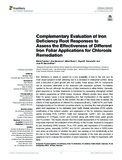Complementary evaluation of iron deficiency root responses to assess the effectiveness of different iron foliar applications for chlorosis remediation
Fecha
2018Versión
Acceso abierto / Sarbide irekia
Tipo
Artículo / Artikulua
Versión
Versión publicada / Argitaratu den bertsioa
Impacto
|
|
10.3389/fpls.2018.00351
Resumen
Iron deficiency in plants is caused by a low availability of iron in the soil, and its main visual symptom is leaf yellowing due to a decrease in chlorophyll content, along with a reduction in plant growth and fruit quality. Foliar sprays with Fe compounds are an economic alternative to the treatment with expensive synthetic Fe-chelates applied to the soil, although the efficacy of foliar treatme ...
[++]
Iron deficiency in plants is caused by a low availability of iron in the soil, and its main visual symptom is leaf yellowing due to a decrease in chlorophyll content, along with a reduction in plant growth and fruit quality. Foliar sprays with Fe compounds are an economic alternative to the treatment with expensive synthetic Fe-chelates applied to the soil, although the efficacy of foliar treatments is rather limited. Generally, plant response to Fe-foliar treatments is monitored by measuring chlorophyll content (or related parameters as SPAD index). However, different studies have shown that foliar Fe sprays cause a local regreening and that translocation of the applied Fe within the plant is quite low. In this context, the aim of this study was to assess the effects of foliar applications of different Fe compounds [FeSO4, Fe(III)-EDTA, and Fe(III)-heptagluconate] on Fe-deficient cucumber plants, by studying the main physiological plant root responses to Fe deficiency [root Fe(III) chelate reductase (FCR) activity; acidification of the nutrient solution; and expression of the Fe deficiency responsive genes encoding FCR, CsFRO1, Fe(II) root transporter CsIRT1, and two plasma membrane H+-ATPases, CsHA1 and CsHA2], along with SPAD index, plant growth and Fe content. The results showed that the overall assessment of Fe-deficiency root responses improved the evaluation of the efficacy of the Fe-foliar treatments compared to just monitoring SPAD indexes. Thus, FCR activity and expression of Fe-deficiency response genes, especially CsFRO1 and CsHA1, preceded the trend of SPAD index and acted as indicators of whether the plant was sensing or not metabolically active Fe due to the treatments. Principal component analysis of the data also provided a graphical tool to evaluate the evolution of plant responses to foliar Fe treatments with time. [--]
Materias
Fe plant nutrition,
Fe deficiency,
Foliar Fe fertilization,
Fe chelates,
Fe(III)-chelate reductase,
Fe (II) transporter,
PM H+-ATPase,
Chlorosis
Editor
Frontiers Media
Publicado en
Frontiers in Plant Science, 2018, 9: 351
Departamento
Universidad Pública de Navarra. Departamento de Ciencias del Medio Natural /
Nafarroako Unibertsitate Publikoa. Natura Ingurunearen Zientziak Saila
Versión del editor
Entidades Financiadoras
This study has been supported by funds from the Government of Navarra, CDTI from the Spanish Government, and Roullier Group.
Aparece en las colecciones
Los documentos de Academica-e están protegidos por derechos de autor con todos los derechos reservados, a no ser que se indique lo contrario.
La licencia del ítem se describe como © 2018 Fuentes, Bacaicoa, Rivero, Zamarreño and García-Mina. This
is an open-access article distributed under the terms of the Creative Commons
Attribution License (CC BY). The use, distribution or reproduction in other forums
is permitted, provided the original author(s) and the copyright owner are credited
and that the original publication in this journal is cited, in accordance with accepted
academic practice. No use, distribution or reproduction is permitted which does not
comply with these terms.






